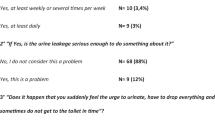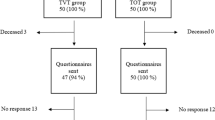Abstract
Introduction and hypothesis
The tension-free vaginal tape ABBREVO (TVT-A) is a new surgical procedure for the treatment of female stress urinary incontinence (SUI). However, data reporting medium- and long-term outcomes are lacking. The aim of the study was to assess the efficacy and safety of TVT-A in patients with at least a 3-year follow-up.
Methods
All consecutive women who complained of pure SUI symptoms with urodynamically proven SUI undergoing a TVT-A procedure were prospectively enrolled. Data regarding subjective outcomes (International Consultation on Incontinence Questionnaire-Short Form, Patient Global Impression of Improvement and patient satisfaction scores), objective cure (stress test) rates and adverse events were collected during follow-up. Univariate analysis was performed to investigate outcomes.
Results
A total of 41 women underwent TVT-A implantation. At 3-year follow-up, 40 women (97.5%) were available for the evaluation. We did not find any significant change in surgical outcomes during this time. At 3 years after surgery, 36 of 40 (90%) patients were subjectively cured (p for trend 0.18) and 37 out of 40 (92.5%) patients were objectively cured (p for trend 0.22). The univariate analysis did not find any risk factor statistically associated with the recurrence of SUI. A significant trend of de novo overactive bladder (OAB) occurrence was registered at the 3-year follow-up (p for trend = 0.03). No serious late complications or groin-thigh pain were reported.
Conclusions
TVT-A implantation is a highly effective option for the treatment of women with pure SUI.


Similar content being viewed by others
References
Wood LN, Tanger J. Urinary incontinence in women. BMJ. 2014;349:g4531.
Fusco F, Abdel-Fattah M, Chapple CR, et al. Updated systematic review and meta-analysis of the comparative data on colposuspensions, pubovaginal slings, and midurethral tapes in the surgical treatment of female stress urinary incontinence. Eur Urol. 2017;72(4):567–91.
Braga A, Caccia G, Sorice P, et al. Tension-free vaginal tape for treatment of pure urodynamic stress urinary incontinence: efficacy and adverse effects at 17-year follow-up. BJU Int. 2018;122(1):113–7.
Bakas P, Papadakis E, Karachalios C. Assessment of the long-term outcome of TVT procedure for stress urinary incontinence in a female population: results at 17 years' follow-up. Int Urogynecol J. 2019;30(2):265–9.
Serati M, Braga A, et al. Tension-free vaginal tape-obturator for treatment of pure urodynamic stress urinary incontinence: efficacy and adverse effects at 10-year follow-up. Eur Urol. 2017;71(4):674–9.
Leone Roberti Maggiore U, Finazzi Agrò E, et al. Long-term outcomes of TOT and TVT procedures for the treatment of female stress urinary incontinence: a systematic review and meta-analysis. Int Urogynecol J. 2017;28(8):1119–30.
Serdinšek T, But I. Long-term results of two different trans-obturator techniques for surgical treatment of women with stress and mixed urinary incontinence: a 10-year randomised controlled study follow-up. Int Urogynecol J. 2019;30(2):257–63. https://doi.org/10.1007/s00192-018-3694-3.
Glavind K, Bjørk J, Kousgaard S. Patient goal achievement 2 years after a tension-free vaginal tape operation. Int Urogynecol J. 2019;30(1):43–46. https://doi.org/10.1007/s00192-018-3716-1.
Lucas MG, Bosch RJL, Burkhard FC, et al. EAU guidelines on surgical treatment of urinary incontinence. Eur Urol. 2012;62:1118–29.
Waltregny D, de Leval J. New surgical technique for treatment of stress urinary incontinence TVT-ABBREVO from development to clinical experience. Surg Technol Int. 2012;22:149–57.
Hubka P, Nanka O, Masata J. TVT ABBREVO: cadaveric study of tape position in foramen obturatum and adductor region. Int Urogynecol J. 2016;27(7):1047–50.
Canel V, Thubert T, Wigniolle I, et al. Postoperative groin pain and success rates following transobturator midurethral sling placement: TVT ABBREVO® system versus TVT™ obturator system. Int Urogynecol J. 2015;26:1509–16.
Bump RC, Mattiasson A, Bo K, et al. The standardization of terminology of female pelvic organ prolapse and pelvic floor dysfunction. Am J Obstet Gynecol. 1996;175:10–7.
Schafer W, Abrams P, Liao L, et al. Good urodynamic practices: uroflowmetry, filling cystometry, and pressure-flow studies. Neurourol Urodyn. 2002;21:261–74.
Haylen BT, de Ridder D, Freeman RM, et al. An International Urogynecological Association (IUGA)/International Continence Society (ICS) joint report on the terminology for female pelvic floor dysfunction. Int Urogynecol J. 2010;21:5–26.
Tubaro A, Zattoni F, Prezioso D, et al. Italian validation of the international consultation on incontinence questionnaires. BJU Int. 2006;97(1):101–8.
Ghezzi F, Cromi A, Raio L, et al. Influence of anesthesia and hydrodissection on the complication rate after tension-free vaginal tape procedure. Eur J Obstet Gynecol Reprod Biol. 2005;118:95–8.
Yalcin I, Bump RC. Validation of two global impression questionnaires for incontinence. Am J Obstet Gynecol. 2003;189:98–101.
Campeau L, Tu LM, Lemieux MC, et al. A multicenter, prospective, randomized clinical trial comparing tension-free vaginal tape surgery and no treatment for the management of stress urinary incontinence in elderly women. Neurourol Urodyn. 2007;26:990–4.
Abdel-Fattah M, Ramsay I, Pringle S, et al. Evaluation of transobturator tension-free vaginal tapes in management of women with recurrent stress urinary incontinence. Urology. 2011;77:1070–5.
Pergialiotis V, Mudiaga Z, Perrea DN, et al. De novo overactive bladder following midurethral sling procedures: a systematic review of the literature and meta-analysis. Int Urogynecol J. 2017;28(11):1631–8.
Serati M, Braga A, Sorice P, et al. Solifenacin in women with de novo overactive bladder after tension-free obturator vaginal tape–is it effective? J Urol. 2014;191:1322–6.
Zacche MM, Mukhopadhyay S, Giarenis I. Changing surgical trends for female stress urinary incontinence in England. Int Urogynecol J. 2019;30(2):203–9.
Kershaw V, Nicholson R, Ballard P, et al. Outcome of surgical management for midurethral sling complications: a multicentre retrospective cohort study. Int Urogynecol J. 2019. https://doi.org/10.1007/s00192-018-3853-6.
Kurien S, Narang S, Han HC. Tension-free vaginal tape-Abbrevo procedure for female stress urinary incontinence: a prospective analysis over 22 months. Singap Med J. 2017;58(6):338–42.
Shaw JS, Jeppson PC, Rardin CR. Decreasing transobturator sling groin pain without decreasing efficacy using TVT-Abbrevo. Int Urogynecol J. 2015;26:1369–72.
Melendez-Munoz J, Braverman M, Rosamilia A, et al. TVT Abbrevo and miniarc suburethral sling in women with stress urinary incontinence—a randomised controlled trial. EJOG. 2018;230:141–6.
Feng S, Luo DY, Liu QY, et al. Three- and twelve-month follow-up outcomes of TVT-EXACT and TVT-ABBREVO for treatment of female stress urinary incontinence: a randomized clinical trial. World J Urol. 2018;36:459–65.
Capobianco G, Dessole M, Lutzoni R, et al. TVT Abbrevo: efficacy and two years follow-up for the treatment of stress urinary incontinence. Clin Exp Obstet Gynecol. 2014;41(4):445–7. https://doi.org/10.12891/ceog19242014.
Natale F, Illiano E, Zucchi A, et al. Transobturator mid-urethral sling in females with stress urinary incontinence and detrusor underactivity: effect on voiding phase. Int Urogynecol J. 2019. https://doi.org/10.1007/s00192-019-03871-7.
Rusavy Z, Masata J, Svabik K, et al. Are the same tapes really the same? Ultrasound study of laser-cut and mechanically cut TVT-O postoperative behavior. Int Urogynecol J. 2018;29(9):1335–40. https://doi.org/10.1007/s00192-017-3516-z.
Duckett J, Bodner-Adler B, Rachaneni S, et al. Management of complications arising from the use of mesh for stress urinary incontinence- International Urogynecology Association Research and Development Committee opinion. Int Urogynecol J. 2019. https://doi.org/10.1007/s00192-019-03935-8.
Author information
Authors and Affiliations
Corresponding author
Ethics declarations
Conflicts of interest
None.
Additional information
Publisher’s note
Springer Nature remains neutral with regard to jurisdictional claims in published maps and institutional affiliations.
Rights and permissions
About this article
Cite this article
Braga, A., Caccia, G., Ruggeri, G. et al. 3-Year follow-up of tension-free vaginal tape—ABBREVO procedure for the treatment of pure urodynamic stress urinary incontinence: efficacy and adverse effects. Int Urogynecol J 31, 739–744 (2020). https://doi.org/10.1007/s00192-019-04096-4
Received:
Accepted:
Published:
Issue Date:
DOI: https://doi.org/10.1007/s00192-019-04096-4




